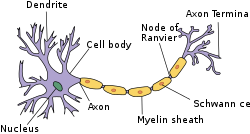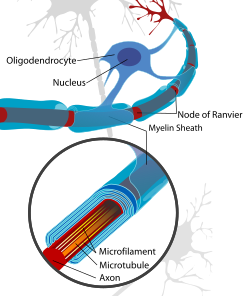Myelin

| Myelin | |
|---|---|
 Structure of simplified neuron in the PNS | |
 Neuron with oligodendrocyte and myelin sheath in the CNS | |
| Details | |
| System | Nervous system |
| Identifiers | |
| FMA | 62977 |
| Anatomical terminology | |
Myelin (
Myelin's best known function is to increase the rate at which information, encoded as electrical charges, passes along the axon's length. Myelin achieves this by eliciting saltatory conduction,[3]. Saltatory conduction refers to the fact that electrical impulses 'jump' along the axon, over long myelin sheaths, from one node of Ranvier to the next. Thus, information is passed around 100 times faster along a myelinated axon than a non-myelinated one.
At the molecular level, the myelin sheath increases the distance between extracellular and intracellular ions, reducing the accumulation of electrical charges. The discontinuous structure of the myelin sheath results in the action potential "jumping" from one node of Ranvier over a long (c. 0.1 mm – >1 mm, or 100-1000 micron) myelinated stretch of the axon called the
Myelin is made by
Development
The process of generating myelin is called myelination or
Species distribution
Vertebrates
Myelin is considered a defining characteristic of the
In vertebrates, not all axons are myelinated. For example, in the PNS, a large proportion of axons are unmyelinated. Instead, they are ensheathed by non-myelinating Schwann cells known as Remak SCs and arranged in
Invertebrates
Functionally equivalent myelin-like sheaths are found in several invertebrate taxa, including
Composition
CNS myelin differs slightly in composition and configuration from PNS myelin, but both perform the same "insulating" function (see above). Being rich in lipid, myelin appears white, hence the name given to the "
In terms of total mass, myelin comprises approximately 40% water; the dry mass comprises between 60% and 75%
Function

The main purpose of myelin is to increase the speed at which electrical impulses (known as
Myelinated fibers lack
Whilst the role of myelin as an "axonal insulator" is well-established, other functions of myelinating cells are less well known or only recently established. The myelinating cell "sculpts" the underlying axon by promoting the
When a peripheral fiber is severed, the myelin sheath provides a track along which regrowth can occur. However, the myelin layer does not ensure a perfect regeneration of the nerve fiber. Some regenerated nerve fibers do not find the correct muscle fibers, and some damaged motor neurons of the peripheral nervous system die without regrowth. Damage to the myelin sheath and nerve fiber is often associated with increased functional insufficiency.
Unmyelinated fibers and myelinated axons of the mammalian central nervous system do not regenerate.[34]
Clinical significance
Demyelination
Demyelination is the loss of the myelin sheath insulating the nerves, and is the hallmark of some
The
Symptoms
Demyelination results in diverse symptoms determined by the functions of the affected neurons. It disrupts signals between the brain and other parts of the body; symptoms differ from patient to patient, and have different presentations upon clinical observation and in laboratory studies.
Typical symptoms include blurriness in the central visual field that affects only one eye, may be accompanied by pain upon eye movement, double vision, loss of vision/hearing, odd sensation in legs, arms, chest, or face, such as tingling or numbness (
Myelin repair
Research to repair damaged myelin sheaths is ongoing. Techniques include surgically implanting
Dysmyelination
Dysmyelination is characterized by a defective structure and function of myelin sheaths; unlike demyelination, it does not produce lesions. Such defective sheaths often arise from genetic mutations affecting the biosynthesis and formation of myelin. The shiverer mouse represents one animal model of dysmyelination. Human diseases where dysmyelination has been implicated include leukodystrophies (Pelizaeus–Merzbacher disease, Canavan disease, phenylketonuria) and schizophrenia.[43][44][45]
See also
- Lesional demyelinations of the central nervous system
- Myelin-associated glycoprotein
- Myelin incisure
- The Myelin Project, project to regenerate myelin
- Myelin Repair Foundation, a nonprofit medical research foundation for multiple sclerosis drug discovery.
- Myelinoid, an in vitro model for studying human myelination and white matter diseases
References
- S2CID 205503852.
- ^ Morell, Pierre; Quarles, Richard H. (1999). "The Myelin Sheath". Basic Neurochemistry: Molecular, Cellular and Medical Aspects. 6th edition. Lippincott-Raven. Retrieved 15 December 2023.
- S2CID 205503852.
- PMID 28340093.
- PMID 9675162.
- PMID 10339541.
- PMID 30050403.
- PMID 31066630.
- PMID 28638987.
- S2CID 195686659.
- S2CID 4961339.
- ^ "Pediatric Neurologic Examination Videos & Descriptions: Developmental Anatomy". library.med.utah.edu. Retrieved 2016-08-20.
- PMID 29772200.
- PMID 29556031.
- PMID 29556025.
- ^ S2CID 33164806.
- ^ PMID 27780071.
- S2CID 20120269.
- PMID 27288241.
- PMID 25921593.
- PMID 18948166– via Elsevier Science Direct.
- S2CID 18442078.
- PMID 25802011.
- PMID 11849988.
- S2CID 9762771.
- ^ a b Saladin KS (2012). Anatomy & physiology: the unity of form and function (6th ed.). New York, NY: McGraw-Hill.[page needed]
- ^ Raine CS (1999). "Characteristics of Neuroglia". In Siegel GJ, Agranoff BW, Albers RW, Fisher SK, Uhler MD (eds.). Basic Neurochemistry: Molecular, Cellular and Medical Aspects (6th ed.). Philadelphia: Lippincott-Raven.
- PMID 28318976.
- PMID 30050403.
- PMID 22622581.
- PMID 22801498.
- PMID 25639777.
- PMID 11598490.
- PMID 19582408.
- S2CID 7499162.
- S2CID 21929640.
- ^ Mayo Clinic 2007 and University of Leicester Clinical Studies, 2014[full citation needed]
- S2CID 34822879.
- "Stem Cell Therapy Replaces Missing Myelin In Mouse Brains". FuturePundit. January 20, 2004. Archived from the original on June 14, 2011. Retrieved March 22, 2007.
- S2CID 2130691.
- PMID 22355115.
- PMID 27099785.
- S2CID 6269094.
- PMID 17093095.
- PMID 16802706.
- PMID 17291371.
Further reading
- Fields, R. Douglas, "The Brain Learns in Unexpected Ways: Neuroscientists have discovered a set of unfamiliar cellular mechanisms for making fresh memories", Scientific American, vol. 322, no. 3 (March 2020), pp. 74–79. "Myelin, long considered inert insulation on axons, is now seen as making a contribution to learning by controlling the speed at which signals travel along neural wiring." (p. 79.)
- Swire M, Ffrench-Constant C (May 2018). "Seeing Is Believing: Myelin Dynamics in the Adult CNS". Neuron. 98 (4): 684–686. PMID 29772200.
- Waxman SG (October 1977). "Conduction in myelinated, unmyelinated, and demyelinated fibers". Archives of Neurology. 34 (10): 585–9. PMID 907529.
